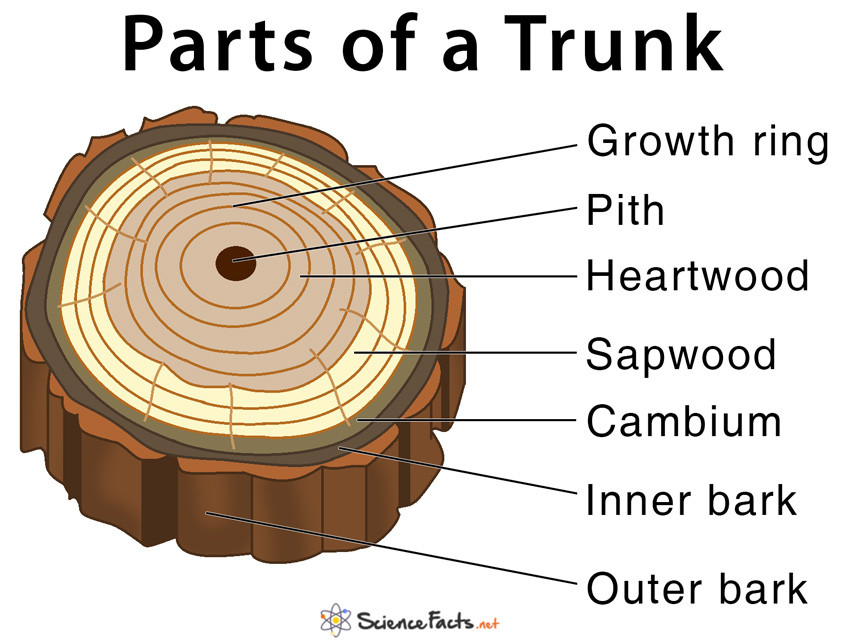Parts of a Tree and Their Functions
Trees are tall and big land plants of the earth that usually survive for many years. They are woody plants that attain a height of about 4.5 meters (15 feet) after reaching full maturity and are found all over the world in high numbers.
All trees have some basic environmental value and provide us with many benefits, such as producing oxygen, purifying the atmosphere, conserving water, preventing soil erosion, giving habitat to a wide variety of insects, birds, and animals. In short, trees help to maintain the balance of nature.
What are the Different Parts of a Tree

A mature tree has three basic parts: 1) roots, 2) crown, and 3) trunk or bole. Although the structure of these parts may vary based on the altitude and geographical position of the tree, each of them performs distinct functions.
1) Roots
Roots are the underground part of a tree. The primary root or taproots grow horizontally downwards, with lateral roots arising from the taproot. Each root is surrounded by many, tiny root hairs that increase their area of absorption.
Functions
- Anchoring the tree to the soil
- Absorbing water and minerals from the soil
- Storing of reserve food
- Preventing soil erosion
2) Crown
They are the topmost portion of a tree that may vary widely based on their shapes and sizes. The crown is made up of the following parts:
i) Leaves: Usually the green part of a plant that remains attached to the crown. Leaves are also known as the factories of a tree. A collection of green leaves is called foliage.
ii) Branches: The first thick branches of a tree arising from the central wooden axis are called boughs while the smallest terminal branches of a tree are known as twigs.
iii) Flowers: The most colorful and attractive part of the plant that remains attached to the terminal branches. It later develops into a fruit.
iv) Fruit: The edible part of the plant that develops from the flowers. It contains the seed that gives rise to a new plant.
Functions
- Leaves produce food for the plant
- Leaves help to filter dust and other particles present in the air, thus keep the air clean
- Leaves keep the plant cool through the loss of water by evaporation
- Twigs help to give rise to new plants
- Boughs and branches store food materials in the form of sugar that are required by the plant for their growth and metabolism
- Boughs and branches provide strength and support to the plant
3) Trunk or Bole
The trunk is the central wooden axis of the crown that is typically brownish. They contain a network of small tubes that runs between the roots and the leaves, thus acting as the plumbing system in the plant. A typical tree trunk shows six parts:

i) Outer bark: The outermost layer of the trunk, branches, and twigs of the tree. The bark of some plants has a characteristic odor and scent.
ii) Cambium: The thin layer of living tissues consisting of growing cells that are present just inside the bark. Every season they add a new layer to its trunk, thus producing a visible annual growth ring in most trees.
iii) Sapwood or xylem: The youngest layers of wood that are made up of a network of living cells. Over the years, the inner layers of sapwood die.
iv) Heartwood: The older and dead xylem cells found close to the center of the trunk and thus are usually darker than xylem. They are filled with stored sugar, oils, and dyes.
v) Pith: The tiny dark spot present at the center of the tree trunk that is highly protected from damage by wind, insects, and animals.
vi) Inner bark or phloem: The pipeline located between the outer bark and the cambium of the tree trunk.
Functions
- Bark protects the delicate inside wood of the tree
- Cambium helps in making new cells thus allowing the tree to grow in diameter
- Outer bark and sapwood helps in supporting the crown and providing the tree its shape
- Pith and sapwood conducts water and minerals from the roots to the leaves
- Inner bark transports the foods prepared by the leaves to all parts of a plant
- Outer bark and cambium provides mechanical strength to the plant
-
References
Article was last reviewed on Friday, July 3, 2020



It’s so good
this helped alot ten out of ten